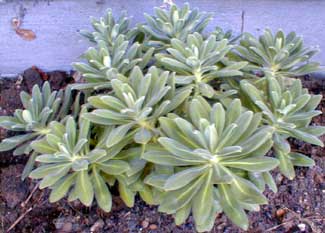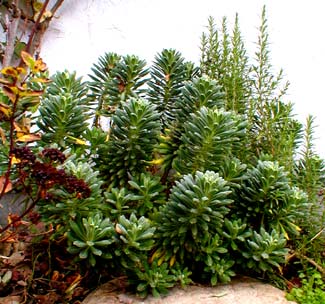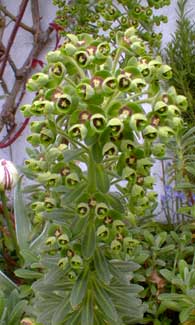
'Portuguese Velvet'
Mediterranean Spurge
"Proud & lowly, beggar & lord,
Over the bridge they go;
Rags & velvet, fetter & sword,
Poverty, pomp, & woe"
-Frederic Edward Weatherly
1848-1929
1848-1929
Evergreen Euphorbia characias 'Portuguese Velvet' is all but unique among euphorbias in that it produces tiny plants at the tops of its own flower stems, & these can be snipped off & planted for easy propagation.
The parent plant tends to wear out in from five to ten years so is not especially long-lived, but can often be refreshed by division, or at the very least is apt to self-seed so that there will be young plants here here & there long before the parent is worn out.
 In spring it produces green bracts & bronzy gold or chrome-yellow flowers. The third photo shows the flower in April (2005).
In spring it produces green bracts & bronzy gold or chrome-yellow flowers. The third photo shows the flower in April (2005).It is also one of the most unusal euphorbias for leaves, as 'Portuguese Velvet' almost looks like it is cut out of greyish green felt, thanks to its minute silver hairs. Euphorbias generally, as well as the majority of "hairy" plants, tend to be the most drought-hardy of perennials, & this one is growing way back under the eaves where rain doesn't reach it, yet it is thriving even though it is hardly ever watered.
This cultivar is compactly leafed & often but a scant foot tall, though two feet tall or a bit more in flower, as opposed to upward toward five feet for the species. In its first year it can have such stubby stems it looks like a shrubby globe exclusively of leaves.
 Very occasional deep watering in summer keeps it going strong, & no watering at all in seasons with any rainfall. It prefers full sun & sharp drainage. Ours is planted at the rear of an area of many tulip bulbs, so that there'll be something evergreen in that spot when there is no sign of tulips, & under the eaves of the house so it is never at risk of being too wet even in the rainy season.
Very occasional deep watering in summer keeps it going strong, & no watering at all in seasons with any rainfall. It prefers full sun & sharp drainage. Ours is planted at the rear of an area of many tulip bulbs, so that there'll be something evergreen in that spot when there is no sign of tulips, & under the eaves of the house so it is never at risk of being too wet even in the rainy season.Our clump is shown in the first photo in September (2003) not long after it was planted from a gallon pot. The second photo is from November (2004), with more than a year of growth. A limb of Upright Rosemary (Rosemarinus officinalis) is intruding from the right, & the winter-browned shrub intruding into the photo from left is a native Rosy Spirea (Spiraea densiflora).
It is hardy to zero degrees & in our mild zone shows little or no damage during the winter. It doesn't get scruffy except when blooms begin to fade away. It will eventually cease to be such a perfectly perennial & need to be trimmed nearly to the ground to start over.
The "blood" or sap of euphorbias is caustic. After any pruning, be sure to wash your hands lest you accidentally rub your eyes, a mistake that is usually only made once.